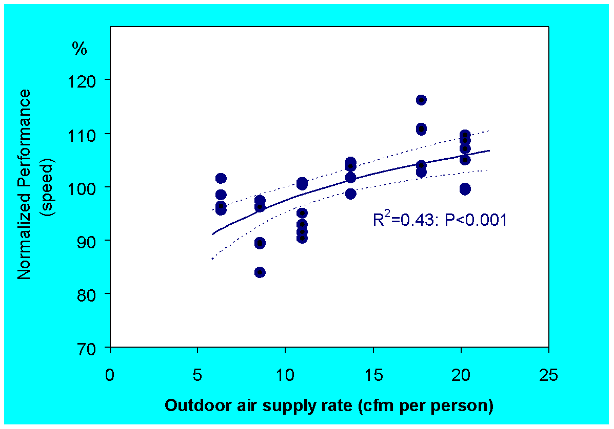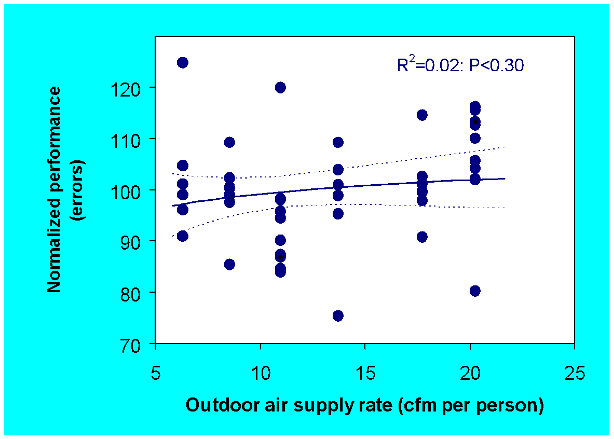Ventilation Rates and School Performance
Ventilation Rates and School Performance
Fisk [1] compiled and summarized the published information on ventilation rates and carbon dioxide concentrations in schools and on the associations of ventilation rates or carbon dioxide concentrations in schools with student performance, health symptoms or signs, and absence rates. When drawing conclusions, the review considered measures of study quality such as study size and the extent to which studies were able to control for potential confounding by factors other than ventilation rates or carbon dioxide concentrations that may also affect student performance, health, or absence.
The reviewed data [1] indicate that ventilation rates in classrooms are often less than required in applicable standards, sometimes far less than required by standards. Correspondingly, peak daily, and even time-average, concentrations of carbon dioxide in occupied classrooms are often double the 1000 ppm levels that indicate that actual ventilation rates approximately equal the ventilation rates specified in standards. The associated data are plotted in the section of this web site in Indoor Air Quality in Schools.
In the reviewed research on associations of ventilation rates or carbon dioxide concentrations with student performance [1], five studies used students’ scores on standard tests of academic achievement to indicate student performance and six studies employed special tests added by the researchers. These special tests typically assessed speed and accuracy in number addition, multiplication, proofreading, logical thinking, and similar activities to indicate performance. Overall, eight out of 11 studies reported statistically significant improvements in at least some measures of student performance with increased ventilation rates or lower carbon dioxide concentrations, and a ninth study reported a statistically significant improvement in performance when applying a less stringent than typical criterion for statistical significance. Five of the studies were intervention studies that increased ventilation rates and measured changes in performance within students. The intervention studies are less subject to error due to confounding by factors other than ventilation rate or carbon dioxide concentration. All of the intervention studies reported statistically significant improvements in some aspects of performance with increased ventilation rates. The reported improvements in performance with increased ventilation rates were typically a few percent, but ranged as high as 15%.
As an example, a U.S. study [2] in 5th grade classrooms from 100 schools used student performance in standard academic tests as the measure of performance. Of the 100 classrooms in the study, 87 had ventilation rates less than the 15 cfm (7.1 L/s) per student minimum requirement in the ventilation standard applicable at the time of the study [3]. In these 87 classrooms, with ventilation rates between 1.9 and 15 cfm per person, the fraction of students passing the standardized math and reading tests increased linearly with ventilation rate. For each 2.1 cfm (1 L/s) per person increase in ventilation rate, there was a 2.9% increase in the proportion of students passing the standardized math test and a 2.7 % increase in the proportion of students passing the standardized reading test. For both math and reading, statistical analyses indicated that the increases in student performance with ventilation rate were very unlikely to be the result of chance. The impacts on performance of increasing ventilation rates above 15 cfm (7.1 L/s) per person were uncertain. In another example, within a Danish study performed in four classrooms [4-6], Wargocki and Wyon used performance tasks representing various aspects of schoolwork, from reading to mathematics that were embedded into the normal school work. The speed and accuracy of task performance was assessed. This study reported a statistically significant 8% increase in speed of school work tasks with a doubling of ventilation rate. There was no statistically significant influence of ventilation rate on the number of errors made by students. Figure 4 provides more detailed results from this study.
 |
 |
Figure 4. Student performance versus ventilation rate based on a study in Denmark [4]. Performance was based on the speed (top figure) and accuracy (bottom figure) of completing various school work tasks. The various data points represent results from multiple experiments and multiple types of work tasks. [Figure 4 reproduced with permission.]
Based on a review of these two example studies and nine additional studies, Fisk [1] concluded that the available research provided “compelling evidence of an association of improved student performance with increased classroom ventilation rates.”
As discussed in the section of this web site focusing on Indoor Air Quality in Schools, higher classroom ventilation rates have also been linked to a reduction in student absence, which, in turn, may improve student learning.
1. Fisk , W.J., The ventilation problem in schools: literature review. Indoor Air, 2017. 27: p. 1039-1051. https://dx.doi.org/10.1111/ina.12403.
2. Haverinen-Shaughnessy, U., D.J. Moschandreas, and R.J. Shaughnessy, Association between substandard classroom ventilation rates and students' academic achievement. Indoor Air, 2011. 21(2): p. 121-31. https://dx.doi.org/10.1111/j.1600-0668.2010.00686.x.
3. ASHRAE, ASHRAE Standard 62.1-2004 Ventilation for acceptable indoor air quality. 2004, American Society for Heating, Refrigerating, and Air Conditioning Engineers, Inc.: Atlanta. Available here.
4. Wargocki, P. and D.P. Wyon, Research report on effects of HVAC on student performance. ASHRAE Journal 2006. 48: p. 22-28.
5. Wargocki, P. and D.P. Wyon, The effects of outdoor air supply rate and supply air filter condition in classrooms on the performance of schoolwork by children. HVAC&R Research, 2007. 13(2): p. 165-191. https://dx.doi.org/10.1080/10789669.2007.10390950.
6. Wargocki, P. and D.P. Wyon, The effect of moderately raised classroom temperatures and classroom ventilation rate on the performance of schoolwork by children. HVAC&R Research, 2007. 13(2): p. 193-220. https://dx.doi.org/10.1080/10789669.2007.10390951.